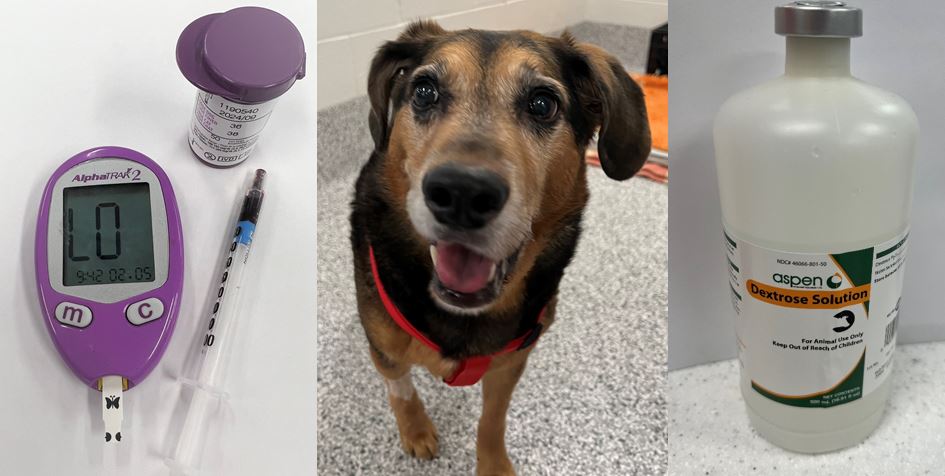-
Adopt
-
Veterinary Care
Services
Client Information
- What to Expect – Angell Boston
- Client Rights and Responsibilities
- Payments / Financial Assistance
- Pharmacy
- Client Policies
- Our Doctors
- Grief Support / Counseling
- Directions and Parking
- Helpful “How-to” Pet Care
Online Payments
Referrals
- Referral Forms/Contact
- Direct Connect
- Referring Veterinarian Portal
- Clinical Articles
- Partners in Care Newsletter
CE, Internships & Alumni Info
CE Seminar Schedule
Emergency: Boston
Emergency: Waltham
Poison Control Hotline
-
Programs & Resources
- Careers
-
Donate Now
 By David Carabetta, DVM, DACVECC-SA
By David Carabetta, DVM, DACVECC-SA![]()
angell.org/emergency
emergency@angell.org
617-522-7282
August 2023
x
x
x
Hypoglycemia is a consequence of many serious disease processes, and without treatment to correct this and the underlying cause, it is commonly fatal. The body has multiple counter-regulatory systems to regulate blood glucose levels to avoid hyper and hypoglycemia. Secretion of insulin in response to hyperglycemia and glucagon and epinephrine in response to hypoglycemia all work to maintain normoglycemia. Many serious systemic illnesses can interfere with glucose hemostasis and lead to life-threatening hypoglycemia. Hypoglycemia deprives cells of glucose necessary for cellular metabolism and can rapidly result in severe clinical signs. Transportation of glucose across the blood-brain barrier relies on a diffusion gradient with arterial blood, and hypoglycemia can result in neuroglycopenia leading to altered mentation and seizures.1
Hypoglycemia in our patients can be seen as a result of multiple severe systemic illnesses, including sepsis, hepatic failure, neoplasia, malnutrition, severe exertion or prolonged seizure activity, and other less common causes. Combining exam findings and basic diagnostics can usually provide a definitive or highly suspected cause for hypoglycemia. Complete blood cell counts may show a severe increase or decrease in white blood cell counts associated with infection and possible sepsis. Severe elevation in transaminases (ALT, AST) can suggest an acute hepatic injury or other changes suggestive of a more chronic hepatic dysfunction (elevated bilirubin, reduced BUN, and cholesterol). Imaging findings may include evidence of aspiration pneumonia or other signs of infection, including peritoneal-free fluid/gas due to GI perforation. Changes in hepatic size on radiographs can suggest a chronic hepatopathy (reduced hepatic size) or infiltrative disease (severe hepatic enlargement).
In less common situations, hypoglycemia can be an unexpected finding in a patient without overt evidence of these conditions. In these seemingly “healthy” patients, we pursue a different diagnostic route looking for illness that affect glucose utilization or production within the body. Accurate diagnosis and treatment of these critical cases are essential and can result in a good long-term prognosis for these patients.
Xylitol is a 5-carbon sugar alcohol used as an artificial sweetener commonly found in gums and other low-carbohydrate products. In canine patients, xylitol results in the inappropriate release of insulin, leading to severe hypoglycemia and altered mentation and seizures.2 Treatment is supportive in nature with supplemental dextrose and blood sugar monitoring until signs have resolved and supplementation can be discontinued. Diagnosis is typically based on clinical history and recent known exposure to xylitol-containing products. Mild elevations in transaminases can be seen in many symptomatic cases, and less commonly, severe hepatic injury and failure can occur. Treatment typically carries a good prognosis in patients that do not develop hepatic failure.
Canine Addison’s disease is commonly considered in patients that present with azotemia and classic electrolyte changes, including hyponatremia and hyperkalemia, which result from a deficiency of the mineralocorticoid aldosterone. A subset of Addisonian patients (~10%) are only deficient in glucocorticoids and lack these electrolyte derangements.3 Lack of glucocorticoids impairs gluconeogenesis and can result in hypoglycemia in a small number of patients (22%), leading to obtundation or seizures.3 Treatment includes supplementation of glucose with injectable dextrose and replacement glucocorticoid therapy. A low baseline cortisol can suggest this condition, and a diagnosis is confirmed with a lack of response on ACTH stimulation testing. This condition also carries a good long-term prognosis with appropriate supplementation of steroid hormones.
Insulinoma is the most common pancreatic neuroendocrine tumor and retains the ability to secrete insulin. Clinical signs associated with it are commonly related to the effects of hypoglycemia leading to neuroglycopenia. Acute treatment of hypoglycemia secondary to insulinoma includes careful glucose supplementation, as further insulin secretion can lead to rebound hypoglycemia with treatment.4 Parenteral administration of steroids can also be beneficial for its effects in inducing insulin resistance. Administration of injectable glucagon can also be used in cases refractory to dextrose and steroid administration and commonly results in the resolution of hypoglycemia.5,6 This short-term treatment option can be useful in stabilizing a patient to allow additional diagnostics and more definitive treatments. A diagnosis of an insulinoma is made by an insulin-glucose ratio showing an inappropriately elevated insulin level with concurrent hypoglycemia. If a mass can be identified and excised via surgery, up to 80% of patients can have a resolution of hypoglycemia and a prolonged median survival (746 days).7

x
References
- Morgan RK, Cortes Y, Murphy L. Pathophysiology and aetiology of hypoglycaemic crises. J Small Anim Pract. 2018 Nov;59(11):659-669
- Lisa A. Murphy, Eric K. Dunayer, Xylitol Toxicosis in Dogs: An Update,Veterinary Clinics of North America: Small Animal Practice,Volume 48, Issue 6,2018,Pages 985-990,
- Klein SC, Peterson ME. Canine hypoadrenocorticism: part I. Can Vet J. 2010 Jan;51(1):63-9. PMID: 20357943; PMCID: PMC2797351.
- Goutal CM, Brugmann BL, Ryan KA. Insulinoma in dogs: a review. J Am Anim Hosp Assoc. 2012 May-Jun;48(3):151-63
- Harris ME, Weatherton L, Bloch CP. Glucagon therapy in canines with an insulinoma: A retrospective descriptive study of 11 dogs. Can Vet J. 2020 Jul;61(7):737-742
- Datte K, Guillaumin J, Barrett S, Monnig A, Cooper E. Retrospective evaluation of the use of glucagon infusion as adjunctive therapy for hypoglycemia in dogs: 9 cases (2005-2014). J Vet Emerg Crit Care (San Antonio). 2016 Nov;26(6):775-781
- Cleland NT, Morton J, Delisser PJ. Outcome after surgical management of canine insulinoma in 49 cases. Vet Comp Oncol. 2021 Sep;19(3):428-441